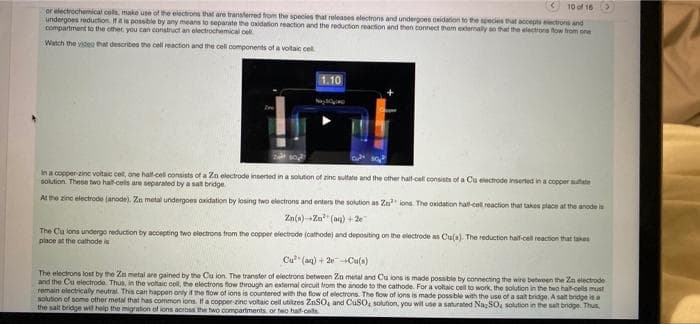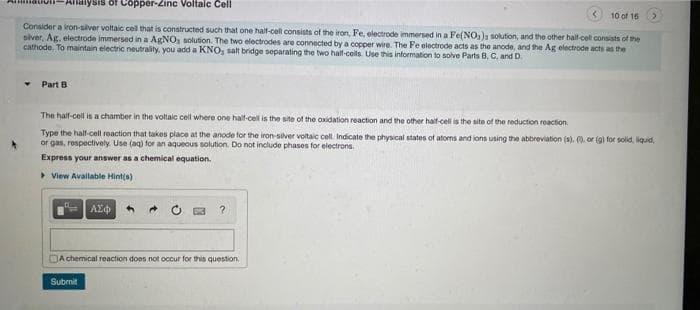Consider a iron-alver voltaic cel that is constructed such that one haif-cell consists of the iron, Fe, electrode immersed in a Fe(NO,)s solution, and the other half-cel consists of the siver, Ag, electrode immersed in a ARNO, solution. The two electrodes are connected by a copper wire. The Fe electrode acts as the anode, and the Ag electrode acte as the cathode. To maintain electric neutrality, you add a KNO, salt bridge separating the two half-cols. Use this information to solve Parts 0, C, andD. Part B The half-cell is a chamber in the voltaic cell where one halt-cell is the site of the oxidation reaction and the other haif-cell is the site of the reduction reaction. Type the hall-cell reaction that taken place at the anode for the iron-silver voltaic cell. Indicate the physical states of atoms and ions using the abbreviation (s), 0), or (g) for solid, liquid, or gan, respectively Use (aq) for an aqueous solution. Do not include phases for electrons. Express your answer as a chemical equation. > View Available Hint(s) A chemical reaction does not occur for this question
Consider a iron-alver voltaic cel that is constructed such that one haif-cell consists of the iron, Fe, electrode immersed in a Fe(NO,)s solution, and the other half-cel consists of the siver, Ag, electrode immersed in a ARNO, solution. The two electrodes are connected by a copper wire. The Fe electrode acts as the anode, and the Ag electrode acte as the cathode. To maintain electric neutrality, you add a KNO, salt bridge separating the two half-cols. Use this information to solve Parts 0, C, andD. Part B The half-cell is a chamber in the voltaic cell where one halt-cell is the site of the oxidation reaction and the other haif-cell is the site of the reduction reaction. Type the hall-cell reaction that taken place at the anode for the iron-silver voltaic cell. Indicate the physical states of atoms and ions using the abbreviation (s), 0), or (g) for solid, liquid, or gan, respectively Use (aq) for an aqueous solution. Do not include phases for electrons. Express your answer as a chemical equation. > View Available Hint(s) A chemical reaction does not occur for this question
Chemical Principles in the Laboratory
11th Edition
ISBN:9781305264434
Author:Emil Slowinski, Wayne C. Wolsey, Robert Rossi
Publisher:Emil Slowinski, Wayne C. Wolsey, Robert Rossi
Chapter31: Determination Of An Equivalent Mass By Electrolysis
Section: Chapter Questions
Problem 1ASA
Related questions
Question
100%
2

Transcribed Image Text:10 of 16
or electrochemical cols, make use of the electrons that are transterred from the species at releases electrons and undergoes onidation to the species that accepts electrons and
undergoes reduction. IAs possble by any means to separate the axidation reaction and the reduction reaction and then connect tham extermaly so that the electrone fow hom one
compartment to the other, you can construct an electrochemical oell.
Watch the videu that describes the cel reaction and the cell components of a voltaic cel.
1.10
oste
In a copper-zine voitaic cel, one halt-cell consists of a Zn electrode insered in a solution of zinc sultate and the other halt-cell consists of a Cu electrode inserted in a copper sutate
solution. These two hat-cels are separated by a sat bridge
At the zino electrode (anode). Zn metal undergoes oxidation by losing two electrons and enters the solution as Zn ions. The oxidation hall-coll reaction that takes place at the anode is
Za(s)--Za" (aa) + 2e
The Cu lons undergo reduction by accepting two electrons from the copper electrode (cathodej and depositing on the electrode as Cula). The reduction half-cel reaction that takes
place at the calhode is
Cu" (aq) + 20Cu(s)
The electrons lost by the Zn metal are gained by the Cu lon. The transfer of electrons between Zn metal and Cu ions is made possible by connecting the wire between the Zn electrode
and the Cu electrode. Thus, in the voltaic coll, the electrons fow through an extermal circuit trom the anode to the cathode. For a voltaic cel to work, the solution in the two halt-cells must
remain electrically neutral. This can happen onty if the flow of ions is countered with the flow of electrons. The flow of lons is made possible with the use of a salt bridge. A salt bridge iaa
solution of some other metal that has common ions. IHa copper-zinc votaic cel ubilzes ZnSO and CuSO, solution, you wil use a sahurated NaSO, solution in the salt bridge. Thus
the salt bridge wil help the migration of ions across the two compartments, or two haif-cells

Transcribed Image Text:naiysis of Copper-Zinc Voltalc Cell
10 of 16
Consider a inron-silver voltaic cell that is constructed such that one half-cell consists of the iron, Fe, electrode immersed in a Fe(NO,) solution, and the other half-cel consists of the
siver, Ag, electrode immersed in a AgNO, solution. The two electrodes are connected by a copper wire. The Fe electrode acts as the anode, and the Ag electrode acts as the
cathode. To maintain electric neutrality, you add a KNO, salt bridge separating the two half-cells. Use this information to solve Parts B. C. and D.
Part B
The half-cell is a chamber in the voltaic cell where one half-cell is the site of the oxidation reaction and the other haif-cell is the site of the reduction reaction.
Type the hal-cell reaction that takes place at the anode for the iron-silver voltaic cell. Indicate the physical states of atoms and ions using the abbreviation (s), ). or (g) for solid, liquid,
or gan, rospectively. Use (aq) for an aqueous solution. Do not include phases for electrons.
Express your answer as a chemical equation.
> View Available Hint(s)
DA chemical reaction does not occur for this question
Submit
Expert Solution
This question has been solved!
Explore an expertly crafted, step-by-step solution for a thorough understanding of key concepts.
Step by step
Solved in 2 steps

Knowledge Booster
Learn more about
Need a deep-dive on the concept behind this application? Look no further. Learn more about this topic, chemistry and related others by exploring similar questions and additional content below.Recommended textbooks for you

Chemical Principles in the Laboratory
Chemistry
ISBN:
9781305264434
Author:
Emil Slowinski, Wayne C. Wolsey, Robert Rossi
Publisher:
Brooks Cole


Principles of Modern Chemistry
Chemistry
ISBN:
9781305079113
Author:
David W. Oxtoby, H. Pat Gillis, Laurie J. Butler
Publisher:
Cengage Learning

Chemical Principles in the Laboratory
Chemistry
ISBN:
9781305264434
Author:
Emil Slowinski, Wayne C. Wolsey, Robert Rossi
Publisher:
Brooks Cole


Principles of Modern Chemistry
Chemistry
ISBN:
9781305079113
Author:
David W. Oxtoby, H. Pat Gillis, Laurie J. Butler
Publisher:
Cengage Learning

Chemistry: Principles and Reactions
Chemistry
ISBN:
9781305079373
Author:
William L. Masterton, Cecile N. Hurley
Publisher:
Cengage Learning

Physical Chemistry
Chemistry
ISBN:
9781133958437
Author:
Ball, David W. (david Warren), BAER, Tomas
Publisher:
Wadsworth Cengage Learning,

Chemistry: Principles and Practice
Chemistry
ISBN:
9780534420123
Author:
Daniel L. Reger, Scott R. Goode, David W. Ball, Edward Mercer
Publisher:
Cengage Learning